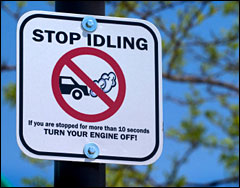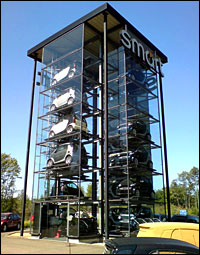
Wherever you are at this moment, you probably won’t stay there long. Most of us don’t like staying. We like leaving — in our cars.
Americans, the owners of nearly 250 million vehicles, take about 356 billion trips in them every year. The total annual distance of all those trips is somewhere in the neighborhood of 2.3 trillion miles, or the equivalent of driving from Pluto to the sun and back — over 300 times.
Toss in the annual leave-takings in the rest of the world’s 600 million cars, and it’s easy to: a) get overwhelmed; or b) decide that the only personal solution to this eco-mess is to take a vow of chassis chastity and never drive again.
We can’t argue with you there: Going car-free is the ne plus ultra in sustainability these days. But if you’re not quite ready to toss the Taurus, there are plenty of other auto actions to take — simple, effective, and painless ones — that can help improve the health of the planet.
Here’s how to start.
Level One: The Baby Steps
Shift your style. Smooth, steady driving (as opposed to the herky-jerky, vroom-and-brake approach) saves huge amounts of gasoline and curbs harmful emissions. Flooring it for just one second can produce nearly the same volume of CO2 as 30 minutes of normal travel. For additional greenness, stick to the speed limit — each 5 mph you drive over 60 mph is like paying an additional $0.20 per gallon for fuel.

Idling ignites plenty of debate. Don’t do it.
Photo: iStockphoto
Don’t idle. As we report in our book Wake Up and Smell the Planet, restarting is the way to go: a car idling for nine minutes emits double the pollutants of a car that is turned off and then restarted. Try to avoid rush-hour traffic, and turn off the engine if you’re at a standstill for 30 seconds or more. Contrary to urban legend, restarting will not waste excess gas.
Get serviced. Keep your car tuned, follow the maintenance guide, and change the oil, air filter, and oxygen sensor when needed: out-of-whack engines reduce fuel efficiency by as much as 20 percent. To minimize drag — another pox on fuel economy — keep your tires properly inflated.

Embrace the virtual commute.
Photo: iStockphoto
Level Two: The Next Steps
Put the tele in your commute. Tell the boss that working from home boosts morale, profits, and eco-friendliness, as well as saving 2 billion gallons of gasoline each year. Or ask to telecommute just one day a week — enough to cut CO2 emissions by 400 pounds each year. Who could say no?
Get flexed. If working remotely isn’t remotely possible, ask for flex-time, a flexible job schedule that allows you to commute at off-peak hours. Get even more eco-maniacal and sign up for a car-sharing service. For a fee that includes gas, insurance, and maintenance, you’ll get to use low-emission, fuel-efficient vehicles — just return ’em to the fleet when you’re done.
Go to mass. Transit, that is. Light rail is best for CO2 savings; buses come in second; and heavy rail takes third. If you can’t use public transport, try carpooling.
Bike, scoot, stroll. Propelling yourself by foot or two wheels is alternately fun, wild, or sexy, which is a lot more than we can say about most forms of four-wheeled travel. Lots of toys can help move you, too, from chic Vespas (Fellini’s fave) to snazzy sport utility bicycles, electric cycles, and category-defiers like the Segway. Or just put on your walking shoes and leave the smallest footprint of all.

Shop smarter.
Photo: Paul-Henri S
Level Three: The Big Step
Get thee to a dealer. When the old Gremlin gives up the ghost, shop carefully for a replacement. Sticker prices on new green cars can run from $21,000 on up — and up, and up. Even used green cars can cost mega-bucks. But if you can get past the affordability hurdle, by all means, leap — or look for a conventional car that gets great mileage. Get the best eco-mileage for the money by using resources like Find a Car, the Environmental Protection Agency’s Green Vehicle Guide, or Yahoo! Autos Green Center to pinpoint the cleanest, most fuel-efficient vehicle that suits your needs. (One car-veat: beware of buying flex-fuel models, which run on an ethanol-gasoline blend that’s not widely available and has debatable eco-benefits.)
Or you could always convert: With a little chutzpah, mechanical talent, and guidance from books and websites, you can transform a gas hog into an electric car or convert a diesel engine into one that runs on pure, used veggie oil. The planet will thank all who fry.
A trunkful of resources … just for you!
Info on green vehicles, alternative fuels, driving, and more:
The EPA’s Green Vehicle Guide
Greener Cars, from the American Council for an Energy-Efficient Economy U.S. Department of Energy/EPA green car find-and-compare service
U.S. DOE’s green car guide
Center for Transportation Excellence
The Green Car Company

Need we say more?
Photo: iStockphoto
Bicycling, walking, and public transit:
Bicycle Fixation
Momentum: The Magazine for Self-Propelled People
Critical Mass
Transportation Alternatives
American Public Transportation Association
Car-free living:
CarFree City USA
World Carfree Network
Telecommuting and business:
Undress For Success
Environmental Leader
Electric car info:
Watch it on YouTube
Electric Cars Are For Girls
EV Album
Vegetable-oil conversion kits:
Greasecar Vegetable Fuel Systems
Frybrid
Greasel
Elsbett


